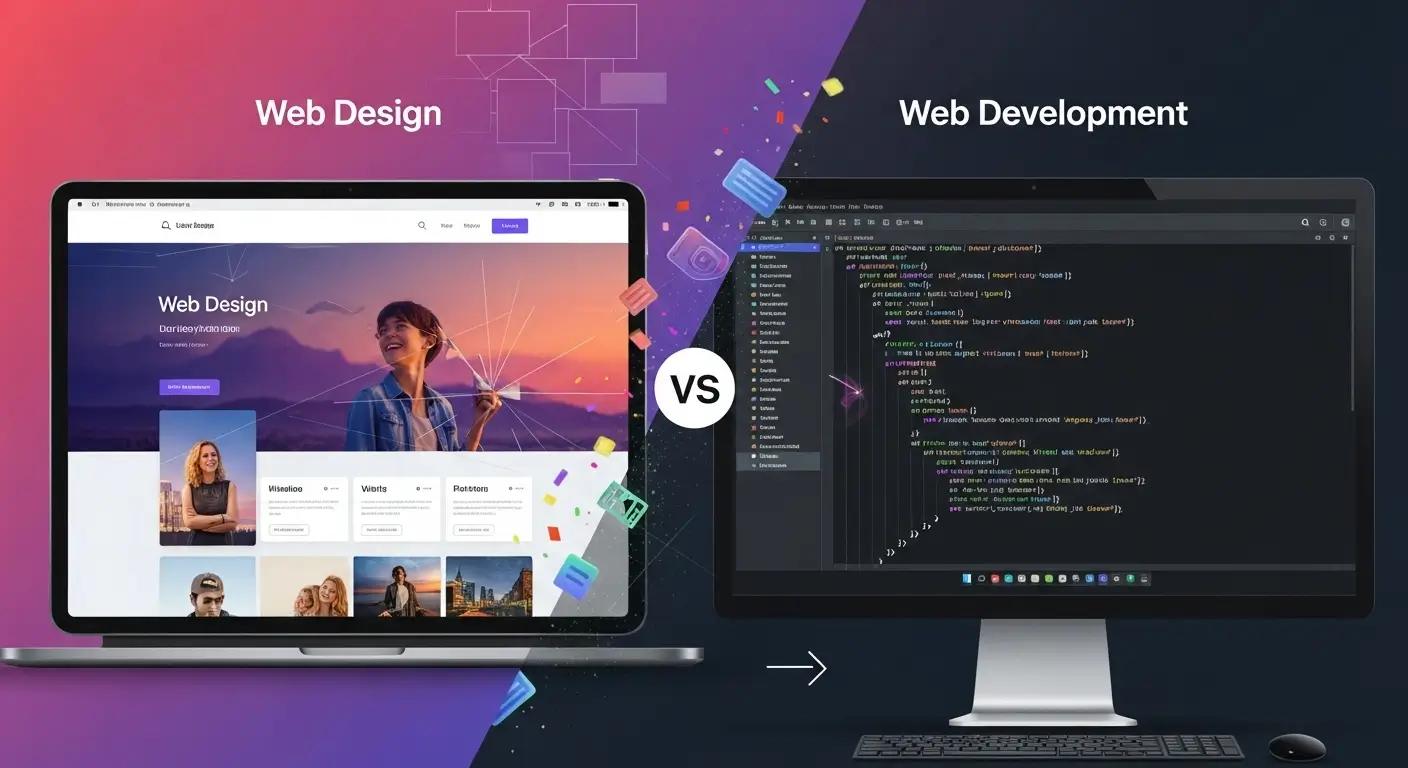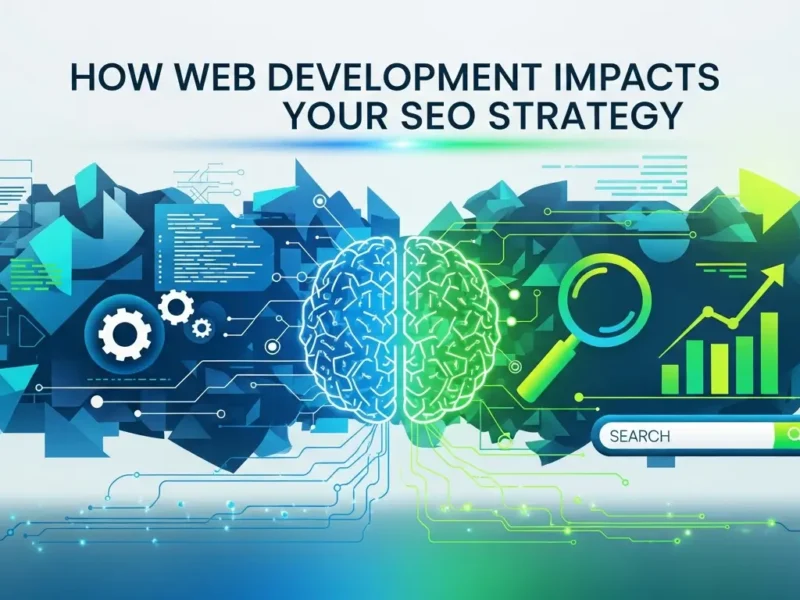In today’s digital-first world, a compelling online presence is non-negotiable for businesses and individuals alike. But behind every stunning website lies a complex ecosystem of skills and processes. Two terms often used interchangeably, yet distinctly different, are web design and web development. While both are crucial for creating a functional and engaging website, they represent unique disciplines that demand different expertise.
So, what’s the real difference between web development and web design? This article will unravel the intricacies of each field, highlight their core functions, and explain how these two indispensable disciplines collaborate to bring a digital vision to life. By the end, you’ll have a clear understanding of what makes a web designer tick and what a web developer brings to the table.
What is Web Design? The Art of Visual Appeal and User Experience
Think of web design as the blueprint and interior decorating of a house. It’s all about how a website looks and feels to the user. A web designer is primarily concerned with the visual aesthetics, layout, and overall user experience (UX) and user interface (UI) of a website. Their goal is to create an intuitive, visually appealing, and brand-consistent digital environment that guides users seamlessly through the content.
The Core Pillars of Web Design: UI and UX
At the heart of web design are two critical components:
- UI Design (User Interface): This focuses on the visual and interactive elements of a website that a user directly engages with. Think about the buttons, icons, typography, color schemes, imagery, and overall layout. UI designers ensure every pixel contributes to an appealing and consistent brand identity. Their work determines whether a website looks professional, modern, and inviting. Tools commonly used include Figma, Sketch, Adobe XD, and Photoshop.
- UX Design (User Experience): This goes deeper than just looks; it’s about how a userfeelswhen interacting with a website. UX designers focus on usability, accessibility, information architecture, and the overall journey a user takes. They conduct research, create wireframes and prototypes, and perform user testing to ensure the website is easy to navigate, efficient, and ultimately satisfying. A good UX designer anticipates user needs and solves potential pain points, making the entire interaction smooth and logical.
Key Skills for a Web Designer: Creativity, a keen eye for aesthetics, understanding of color theory and typography, empathy for users, proficiency in design software, knowledge of responsive design principles, and an understanding of human psychology.
What is Web Development? Bringing Designs to Life Through Code
If web design is the blueprint, then web development is the actual construction of the house, laying the foundation, erecting the walls, installing plumbing and electricity, and ensuring everything works perfectly. A web developer takes the visual concepts and functional requirements meticulously crafted by the designer and transforms them into a live, interactive website using various programming languages and technologies. They are the engineers who build the backbone and functionality of the web, often providing comprehensive web development services tailored to specific client needs.
Web development is typically broken down into three main areas:
Front-End Development: The Client-Side Magic
Front-end developers are responsible for everything the usersees and interacts with directlyin their browser. They translate the web designer’s UI/UX vision into functional code. This includes implementing the layout, styling, interactive elements, and ensuring the website is responsive across different devices and browsers.
Core Technologies:
- HTML (Hypertext Markup Language): The foundational language for structuring content on the web (headings, paragraphs, images, links).
- CSS (Cascading Style Sheets): Controls the visual presentation of HTML elements (colors, fonts, spacing, layout).
- JavaScript: Adds interactivity and dynamic behavior to websites (animations, forms, dynamic content updates).
- Frameworks & Libraries: Tools like React, Angular, and Vue.js streamline the development of complex user interfaces.
Back-End Development: The Server-Side Engine
Back-end developers focus on the “behind-the-scenes” functionality that users don’t directly see but is essential for a website to operate. This includes server configuration, database management, application logic, and ensuring data security and performance. They build the infrastructure that allows the front-end to function, processing information, storing data, and communicating with servers.
Core Technologies:
- Programming Languages: Python, PHP, Ruby, Java, Node.js, C#.
- Frameworks: Django (Python), Laravel (PHP), Ruby on Rails (Ruby), Express.js (Node.js).
- Databases: MySQL, PostgreSQL, MongoDB, SQL Server (for storing and managing website data).
- Servers: Apache, Nginx (for hosting the website).
Full-Stack Development: The Jack-of-All-Trades
A full-stack developer is proficient in both front-end and back-end technologies. They possess the skills to work on all layers of web development, from designing the user interface to managing servers and databases. While highly versatile, this path requires a broad and deep understanding of many different tools and languages.
Key Skills for a Web Developer: Strong logical thinking, problem-solving abilities, proficiency in coding languages, understanding of algorithms and data structures, attention to detail, debugging skills, and a commitment to continuous learning in a rapidly evolving tech landscape.
How Web Design and Web Development Collaborate
It should be clear by now that web design and web development are not opposing forces but rather two sides of the same coin. A beautiful design without robust development is just a picture, and powerful code without thoughtful design is a confusing mess. They are inherently symbiotic.
The typical workflow involves:
- Discovery & Strategy: Both teams collaborate to understand project goals, target audience, and functional requirements.
- Design Phase: Web designers create wireframes, mockups, and prototypes, often presenting them to the client for feedback. They hand off detailed design specifications to the developers.
- Development Phase: Front-end developers translate the approved designs into interactive web pages. Back-end developers build the server, database, and application logic.
- Testing & Deployment: Both teams rigorously test the website for functionality, usability, performance, and cross-browser compatibility before it goes live.
- Maintenance & Iteration: Ongoing updates, bug fixes, and feature additions ensure the website remains current and effective.
Constant communication between designers and developers is paramount. Developers might offer insights into the feasibility of certain design elements, while designers might refine their work based on technical constraints or opportunities. Together, they create a complete, user-friendly, and powerful online experience.
Choosing Your Path: Designer, Developer, or Both?
For those looking to enter the digital landscape, understanding these differences is crucial.
- If you’re drawn to visual aesthetics, user psychology, and crafting intuitive experiences, web design might be your calling, with many professionals offering specialized web design services to businesses seeking a compelling online presence.
- If you love problem-solving, logical thinking, and bringing complex systems to life through code, web development is likely a better fit.
- And if you thrive on mastering both creative and technical challenges, full-stack development offers a comprehensive journey.
Both fields are in high demand and offer rewarding career paths in our increasingly interconnected world.
Conclusion
In essence, web design answers the question “What does it look like and how does it feel to use?” focusing on the aesthetic and experiential journey. Web development answers “How does it work and what makes it function?” focusing on the technical construction and underlying logic.
While distinct in their methodologies and skill sets, web design and web development are inextricably linked. They are two foundational pillars that, when combined effectively, create websites that are not only beautiful and engaging but also robust, functional, and capable of achieving their strategic objectives. Understanding this vital distinction is the first step toward appreciating the intricate craftsmanship behind every digital experience.



